By Ellen | September 4, 2009
Here are more pictures of children at Morningside Hospital in 1923. Children were sent to Morningside because they had mental and physical disabilities, many of which we would call developmental disabilities today. This is the diagnosis for a child from Anchorage:
“Adrnitted November 7,1925. Anchorage. A native child of four years. Speaks no English. Physical examination affords no information aside from partial deafness. Physical condition good,”
The caption on the first photo below is, ” Orphans of the Far North – Alaska defectives happily housed in the mild climate at Morningside.”
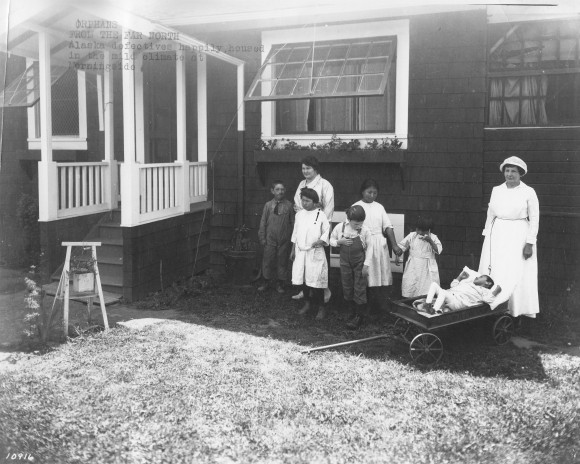
Record Group 126, Records of the Office of the Territories, National Archives II, College Park, MD
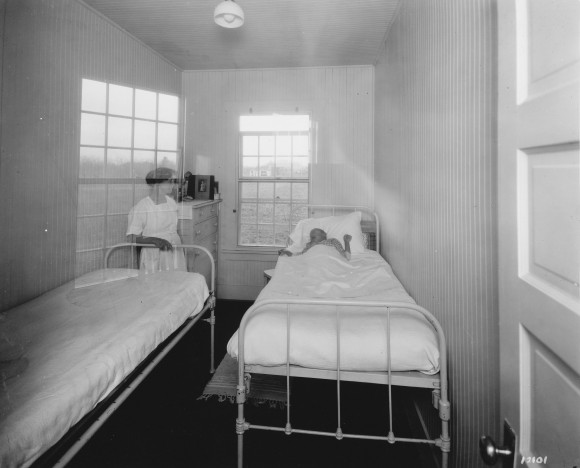
Record Group 126, Records of the Office of the Territories, National Archives II, College Park, MD
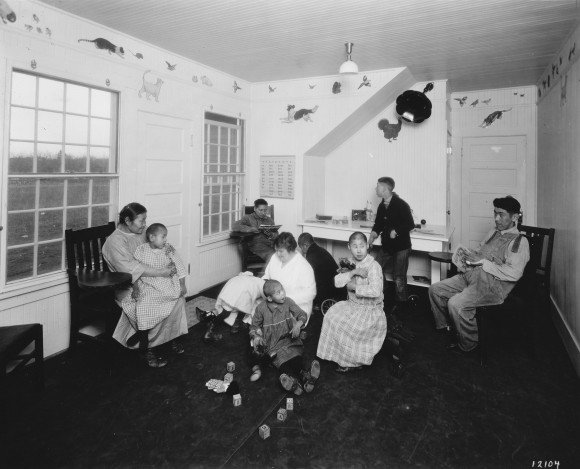
Record Group 126, Records of the Office of the Territories, National Archives II, College Park, MD
By Ellen | September 2, 2009
It was never clear to me when Morningside Hospital started admitting children. The patient lists during the early years seemed to be populated by miners, gamblers and other who came North to seek their fortunes. By the time Alaska assumed responsibility for providing mental health services to its citizens in 1956, a significant percentage of patients at Morningside were children with developmental disabilities. Some admitted soon after birth.
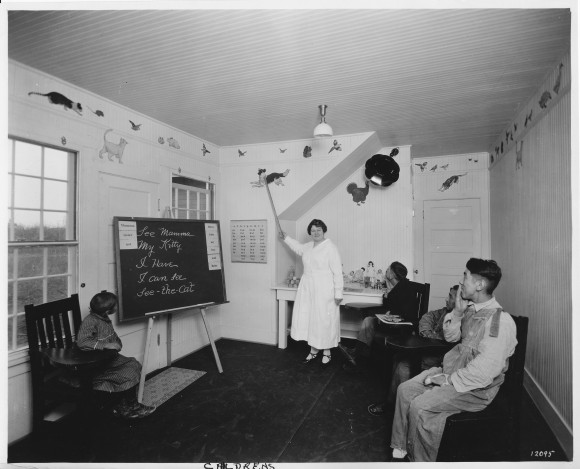
Record Group 126, Records of the Office of the Territories, National Archives II, College Park, MD
The National Archives II provided the following information from the Department of the Interior files:
On November 9, 1922, Scott C. Bone, the Governor of Alaska, sent a telegram to the Secretary of the Interior asking, “Can mentally defective children of Alaska be committed to Morningside under existing contract stop Institution is now equipped to handle such cases.”
The next day, Assistant Secretary of the Interior F. M. Goodwin responded, “Replying your telegram November ninth. Unless mentally defective children of Alaska are legally adjudged to be insane they cannot be cared for at Morningside Hospital under the contract with Sanitarium Company.”
The decision to commit children to Morningside in the same way adults were handled apparently came swiftly. Children were taken before a jury of six men and adjudicated “insane”. The photo above is from 1923.
Also posted in Patient Photos |
From “The East Portland Historical Overview and Historic Preservation Study” published by the City of Portland Bureau of Planning and Sustainability (March 2009)
“For nearly sixty years, Morningside Hospital sat on a 47-acre parcel in Hazlewood, at the junction of SE Stark Street and 96th Avenue. Formerly agricultural land, the site was developed as a psychiatric hospital complex and working farm in 1910. After WWII, many of the farmers in the surrounding area retired and their land was developed into suburban communities. The rising population increased consumer demand and the under-construction interstate freeway promised easy access; in 1970 the site was redeveloped as Mall 205.
The hospital, founded in 1899 by Dr. Henry Waldo Coe, was originally run out of his family’s home. In 1905, Coe purchased the Massachusetts Building from the Lewis and Clark Exposition and moved it from the exposition site in NW Portland to Mt. Tabor, where it was converted into a psychiatric hospital. Five years later, Dr. Coe moved Read More »
The 1920 US Census data has been posted and added to the Wall of Names. The Census data is interesting in that it contains information that our other lists do not, including birthplace, marital status, literacy, race, and mother tongue, all of which will be helpful to researchers tracking down family history. This was a hand-written document that had to be transcribed into a spreadsheet, we’ve done our best to ensure the data was copied accurately, but there may be typos.
You can view these lists here: 1920 US Census
When we posted the 1955 Department of the Interior Report, we pointed out some names that appeared on both that list and the Wickersham Papers. With the addition of the 1920 US Census list there are even more names that appear on multiple lists, helping to fill out the profile of some Morningside patients. Read More »
Over the years, there were numerous occasions when concerns were raised about the quality of care provided by Morningside Hospital. The earliest we’ve found was in 1915. The Sunday, March 28, 1915 issue of the Atlanta Constitution included the following story:
Syndicate Enriched from Insane Asylum
Juneau, Alaska. March 27 – A report criticising the Morningside sanitarium at Portland Ore., where Alaska insane are cared for under contract with the government, was returned yesterday by the judicial committee of the territorial legislature. The report demanded “that conditions there, by which the syndicate is enriched $30,000 annually, be improved.” Read More »
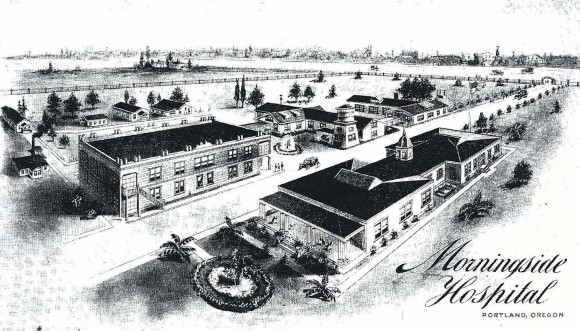
A picture showing the Morningside Hospital circa 1925.
Morningside Hospital was located on the current site of Mall 205, a community shopping center off Interstate 205 in East Portland.
[mappress mapid=”1″]
Prior to the Alaska Mental Health Enabling Act of 1956, a person accused of being mentally ill was to be brought before a jury of six people, who would rule him sane or insane. The patient was often sent to prison until his transfer to Portland. Medical or psychiatric exams were not required. This commitment process was established in 1905 by the 58th US Congress.
The full text for the part of the act relating to, “the care and support of insane persons in the district of Alaska…”, can be found here.
The following post comes from the website of the Oregon Health Sciences University (OHSU) from a paper written by Olof Larsell, an Oregon medical historian.
Larsell writes: “The gold rush to Alaska, beginning in 1897, had burdened the federal government with responsibility for gold seekers whose minds broke under the hardships and strain of their search for quick wealth. The nearest mental hospitals were at Steilacoom, Washington, and Salem, Oregon. On January 16, 1901, the Oregon State Insane Asylum, at the request of the United States government, entered into a contract to care for the Alaska insane at $20.00 per month per patient.” Read More »
Many of the children and adults who were sent to Morningside from Alaska never returned home. Often, they became faint memories or a part of family history that can’t be verified. The uncle no one talks about or the child everyone assumes died.
One of the things we’d really like to do is collect and make available the names of as many Morningside patients as possible, with the hope that families can find long-lost relatives and fill in the empty spaces on family trees.
The first installment is a list of all patients admitted to Morningside from 1904 to 1916. This information came from the papers of Judge James Wickersham, who was the Alaska delegate to Congress in the early 1900s. The spreadsheet includes the information as it was originally organized, and then a series of spreadsheets organized by admission date, disposition and the community the person came from in Alaska.
We also have patient lists from the 1920 and 1930 U.S. Census records. We’ll post them as soon as we get them into spreadsheets.
By Ellen | April 28, 2009
“…the climate of Alaska is none too good for an insane patient. Winter sunlight lasts but a few hours in the day in the interior, and winter rains are largely constant upon the coast, the rainfall at Sitka and Juneau being about 90 inches per year. The undue length of the days in midsummer also seems to be as trying upon mental patients as the long nights of winter.”
The Institutional Care of the Insane in the United States and Canada (1916)





